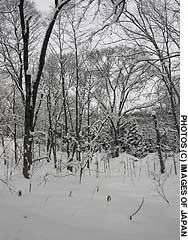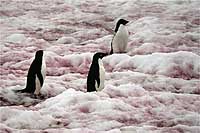Delving deeper into the snows
By Mark Brazil | Feb 6, 2003
SUBNIVEAN ECOSYSTEMSAt the end of my column last week, there I was on the Antarctic Peninsula pondering the pink hue of “watermelon snow” and wondering where had I heard about colored snow before.
Eventually the fuzzy memory of a ridiculous refrain came back to me; a refrain about a stereotypical Eskimo called Nanook (nanuq means polar bear in Eskimo languages) battling against an evil fur trapper and having only one weapon to wield — a yellow dog-doo snow cone. Showing my age here, it was from the late Frank Zappa’s 1974 album, “Apostrophe.”
Zappa may have thought he’d invented the idea of yellow snow, but there are microbiologists out there who really do study it, though they are equally absorbed by red, green and orange snow. Colored snow isn’t quite the rarity you might think.
The next time you are out shoveling, clearing your porch or driveway, be reminded that there is actually an International Commission of Snow and Ice, whose Snow Ecology Working Group covers the interdisciplinary science of snow-covered (or “subnivean”) ecosystems.
Snow is a major element in the environment. Creatures that inhabit areas where snow cover lasts all winter adopt very different lifestyles from those that live where snow cover is brief or absent.
Humans have been very inventive in adapting to snow-covered environments in terms of transport, housing and clothing. Think of toboggans, snowshoes and skis, or igloos and sealskin parkas for starters — all address the local characteristics of snow’s thickness, hardness, and duration. Some cultures have adapted to permanent winter snow cover, but in most developed countries, snow is typically regarded as something to be removed — and quickly — at the cost of vast sums each winter to clear it from runways, roads and walkways.
Selective pressure
However, snow cover is a crucial component of the world climate system. Directly or indirectly, it affects all ecosystems, and warmer global and regional temperatures trigger physical changes in it that can lead to other ecological developments.
The physical properties of snow, particularly its weight, significantly affect plant growth and distribution. Qali, for example, the snow that accumulates on tree branches, acts as a selective pressure, breaking off weak and dying limbs. And beneath trees there is a bowl-like depression, or qamaniq, where snow cover is thinner. However, a layer of snow actually insulates the ground from particularly frigid temperatures so that it becomes a subnivean zone inhabited by various small mammals. Some small birds seek food down there, too.
Snow cover affects birds in various ways. After heavy windblown snow, woodland birds such as nuthatches and treecreepers that normally spiral their way around tree trunks, go either straight up or zigzag on the narrow snow-free side. Woodland birds that forage high in the trees for much of the winter suddenly feed from much lower down in late winter because the snow around the bases of the tree trunks is the first to melt, exposing food that would otherwise remain hidden throughout the winter.
Prolonged winter snow cover of course dominates tundra and taiga life, as well as alpine regions around the world, even lowland areas in places such as Hokkaido. In such regions, certain creatures live out their winter lives in the subnivean layer, accompanied by colorful spring-blooming snow algae — including the pink ones that produce watermelon snow.
Altogether, around 350 species of these snow algae have been identified so far, thriving in deep, persistent snowfields on all continents and supporting a food web of tiny snow creatures.
To find snow algae, look for serious snow, long-lasting and more than a meter deep. There you may come across a red species (first reported by Aristotle more than 2,000 years ago), such as Chlamydomonas nivalis, while 10 or 20 cm beneath the surface you may find green snow algae of the genus Chloromonas in bloom. Orange, or salmon-colored algae are more light-tolerant than green, but less so than red snow algae.
Meltwater currents
The red blush, the orange tint or the green caste of a springtime snow bank comes from the pigments in algal cysts. In summer, as the last of the snow patches melts, the cysts settle onto the ground sometimes so densely that they form a crust like dried blood. There, they survive the summer and await the arrival of the next winter’s snowfall. As this begins to melt the following spring, the cysts burst open and release single cells with whiplike tails that swim up the current of meltwater like salmon swimming upriver to spawn.
They are in a race for the surface or near-surface, for that is where these microscopic organisms reproduce — and they must do so before all the snow melts.
Near the surface, they mate and form protective time-capsule cysts that will see them through the drifting journey back down to the ground and through another year.
Snow algae are tough. They have chemical tricks (special fatty acids in their cell membranes that keep them fluid at low temperatures) that enable them to withstand extreme cold, and a range of sun-blocking carotenoid pigments that shield their cells from excessive sunlight. Green algae, lacking carotenoids, suffer much more from full sunlight and so shield themselves beneath a deeper layer of snow.
Snow algae are primary producers; they capture energy from the sun, making it available for an entire food web. Bacterial colonies develop around the algae, and microscopic predators take advantage of the availability of food. Rotifers, collembola (snow fleas), tardigrades (water bears) and various snow worms are part of this virtually invisible ecosystem. Fungi join in the fun, too, finding plenty of material to decompose in the living snowfield community, as they weave their way through it.
Thus the apparent barrenness of a white expanse of snow is deceptive: It’s a whole freshwater ecosystem.


